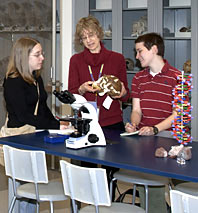
T here isn’t much question of where Eliot Spitzer’s views lie when it comes to the politics of intelligent design. The governor’s own name—or, more accurately, those of his parents—has been emblazoned, after a $15 million donation, on the Anne and Bernard Spitzer Hall of Human Origins at the American Museum of Natural History. Kids younger than Eliot will find lots to do there as well, as the hall includes a lab where young scientists-to-be will be invited to draw samples of their own DNA. Don’t worry, there are no needles or extractions of bodily fluids here: A quick Gatorade gargle, spit into a beaker, includes more than enough cells for the sample. From there, kids will add a little soap (to break down cell membranes) and then ethanol, and voilà: Silvery strands, visible without a microscope, will appear. That’s a remarkable measure of how fast biological science has developed: Since 1953, when DNA’s double helix was first presented by Watson and Crick at the Cold Spring Harbor Laboratory on Long Island, it’s gone from cutting-edge science to preteen demo. And C. Erin McKechnie, the workshop facilitator whose day job is at Cold Spring Harbor, says the rate of advancing discovery is still breakneck. “When I look out at the audience, I realize they will learn more about genetics than I know today,” she says. “Someone younger than I am will know more than I do.”
3/24 and 4/21 from 11 a.m. to 12:30 p.m. for kids 8 through 10, 1:30 to 3 p.m. for kids 10 through 12; American Museum of Natural History, Sackler Educational Laboratory, 79th St. and Central Park W., first floor (212-769-5200 or amnh.org); $35 per pair.